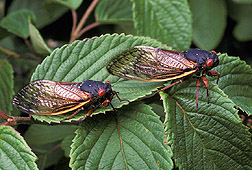This page has been archived and is being provided for reference purposes only. The page is no longer being updated, and therefore, links on the page may be invalid.

Cicadas. Click the image for more information about it.

Cicada nymph. Click the image for more information about it.
After 17 Years, the Cicadas Are Coming
By Luis Pons
April 21, 2004
After a 17-year wait, billions of large, noisy, winged, red-eyed insects known as periodical cicadas (Magicicada spp.) will soon emerge from the ground, occupying large swaths of the eastern United States. They'll overrun many yards, pelt windows, fly into people, clog storm drains and basically wreak buggy havoc.
But entomologist Michael Schauff of the Agricultural Research Service's (ARS) Systematic Entomology Laboratory in Beltsville, Md., has a message: Remain calm. Although cicadas may give many people the creeps, the bugs won't sting or bite, and they rarely damage plants.
According to Schauff, the cicada explosion will start in early-to-mid May in parts of Virginia, West Virginia, Maryland, Pennsylvania, Delaware, New Jersey, western North Carolina, Kentucky, Georgia, Tennessee, Ohio, Indiana and southern Michigan. Other states may see them as well. This activity will peak between mid-May and mid-June, and the insects will die off about four weeks after first emerging.
Schauff has good agricultural news as well: The cicadas pose little threat to crops, although small or newly planted hardwood or fruit trees and grape vines may need protection. That's because cicadas make small incisions near the tips of tree branches, where they lay eggs. The branch beyond the incisions often dies.
The 17-year cicada is known as Brood X (10), or the Big Brood. Other broods have different cycles, and are not as intensely populated.
According to Schauff, the first sign of the cicada emergence will be little mounds or mud turrets that look like miniature volcanoes around the bases of trees. The insects emerge soon after.
Six to 10 weeks after eggs have been laid, nymphs will emerge, fall to the ground, crawl into the soil and stay out of sight as they slowly develop in cells attached to plant roots, subsisting on tree sap over the next 17 years.
ARS is the U.S. Department of Agriculture's chief scientific research agency.
